So today was the day I have been planning for. Reading, watching youtube instruction videos, surfing the internet, reading HBT posts, and today it culminated with my first brew day. I decided to get straight to business, all-grain or bust.
Here's the recipe for the oatmeal stout I followed (I got it from Natchel's Homebrewing for Dummies):
---
Grains:
7 lbs. 2-row pale malt
0.5 lb. 2-row dextrin malt
1 lb. roasted barley
0.5 lb. 2-row dark caramel malt
1 lb. flaked barley
1 cup wheat malt
1 lb. oatmeal
Hops:
1.75 oz. Northern Brewer (6.8 AAU) for 60 minutes
Yeast:
Wyeast 1056
Mash at 130*F for 20 minutes, raise to 155*F for 1 hour
---
Here's my setup ... It was much more organized at the beginning of the brew day ... looked like chaos at the end.
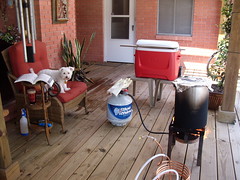
As you can see, I used a cooler for my MLT (with the SS tube strainer), a 30 qt. aluminum turkey fryer (with propane burner kit), and a 3/8" x 20' copper immersion wort chiller that I made.
First on the day's list of tasks was cleaning and sanitation. I used iodophor, and was very pleased with how easy it was to use. I filled my fermenter with it, soaked everything in that, and filled a small spray bottle that I used throughout the day (I used almost the entire spray bottle!).
The first mistake I made was that I added 1 *pound* of wheat malt, instead of 1 *cup* ... I didn't catch my mistake until about 5 minutes ago.
Other than that, I had some temperature issues when trying to get my mash to 130*F (had to add some ice cubes, added too many, so then had to add more hot water), and even more difficulty getting the temp up to 155*F for the second stage of the mash. All in all, I think I added around 6 gallons of water to the mash, not even counting the sparge.
I vorlaufed, then drained off the wort into my kettle, getting about 5 gallons of first runnings. I sparged 1.5 additional gallons which brought the volume in my boil kettle up to 6.5 gallons. Had the color I was going for .
.
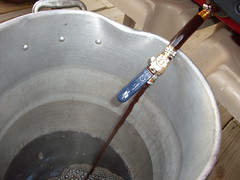
Next I brought the wort up to a boil, added the 1.75 ounces of Northern Brewer hops (did this very carefully, first stirring the wort into a small whirlpool which I think prevented a boil-over), and sat back with a Guinness (this is my first brew, so no homebrews for me ... yet). Here's some of the leftover wort (I like the color), and the hops that I used.
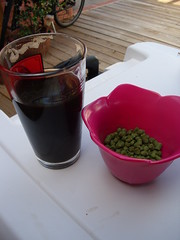
I was very pleased to complete the boil without any boil-overs ... I had expected it to be disastrous, considering how little room there was between the wort and the pot's rim. 10 minutes prior to flame-out, I put the immersion chiller in. At flame out, I turned on the immersion chiller, and noticed this (which had not happened in the tests when I built it):
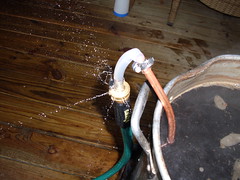
None of the water spray was going anywhere near the wort, so I figured it was harmless. About 40 minutes later, my wort was chilled to 79*F. OG came out to 1053 (1051 on the hydrometer, +.002 for temperature), which I'm pleased with (Homebrewing for Dummies said an OG range I think from 1038 to 1058).
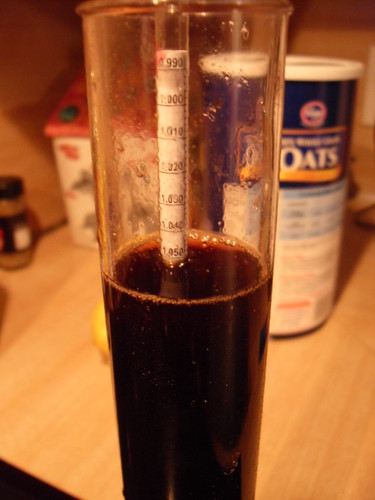
Finally, I took a drink from the hydrometer's sample. Man, does this thing have some bitterness. It's like an IPA. One concern I have, then, is definitely whether I made this too hoppy, even though I followed the recipe verbatim (well, except for that whole 1 cup of wheat malt thing). The other concern (or more just curiosity) is what effect the 1 pound of wheat malt as opposed to 1 cup might have on the finished product.
The auto-siphon that I thought would be the greatest thing in the world did not work for me. I could get it to work for a few seconds, but it would gradually reduce its flow and then just stop altogether. I followed all directions for the auto-siphon and even watched videos of others using it ... I'm at a loss regarding it. Instead, I used a sanitized pitcher to transfer the cooled wort into the fermenter, until the pot was light enough that I could just dump it all in (strained, of course).
Here's the brew, 5.5 gallons of it and with yeasties ready to attack, all set up to ferment in its primary for the next week. Temperature is pretty stable in the upper 60's here.
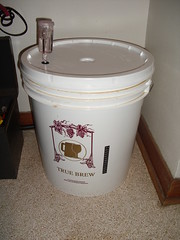
Anywho, that was my first brewing experience, and my first all-grain! It was a fun brew-day, and I'd like to thank the HBT forums and the advice from my local beer club (shout out to Golden Triangle Homebrewers Club) for all their help . Thanks for reading, and please don't hesitate to point out room for improvement!
. Thanks for reading, and please don't hesitate to point out room for improvement!
Here's the recipe for the oatmeal stout I followed (I got it from Natchel's Homebrewing for Dummies):
---
Grains:
7 lbs. 2-row pale malt
0.5 lb. 2-row dextrin malt
1 lb. roasted barley
0.5 lb. 2-row dark caramel malt
1 lb. flaked barley
1 cup wheat malt
1 lb. oatmeal
Hops:
1.75 oz. Northern Brewer (6.8 AAU) for 60 minutes
Yeast:
Wyeast 1056
Mash at 130*F for 20 minutes, raise to 155*F for 1 hour
---
Here's my setup ... It was much more organized at the beginning of the brew day ... looked like chaos at the end.

As you can see, I used a cooler for my MLT (with the SS tube strainer), a 30 qt. aluminum turkey fryer (with propane burner kit), and a 3/8" x 20' copper immersion wort chiller that I made.
First on the day's list of tasks was cleaning and sanitation. I used iodophor, and was very pleased with how easy it was to use. I filled my fermenter with it, soaked everything in that, and filled a small spray bottle that I used throughout the day (I used almost the entire spray bottle!).
The first mistake I made was that I added 1 *pound* of wheat malt, instead of 1 *cup* ... I didn't catch my mistake until about 5 minutes ago.
Other than that, I had some temperature issues when trying to get my mash to 130*F (had to add some ice cubes, added too many, so then had to add more hot water), and even more difficulty getting the temp up to 155*F for the second stage of the mash. All in all, I think I added around 6 gallons of water to the mash, not even counting the sparge.
I vorlaufed, then drained off the wort into my kettle, getting about 5 gallons of first runnings. I sparged 1.5 additional gallons which brought the volume in my boil kettle up to 6.5 gallons. Had the color I was going for

Next I brought the wort up to a boil, added the 1.75 ounces of Northern Brewer hops (did this very carefully, first stirring the wort into a small whirlpool which I think prevented a boil-over), and sat back with a Guinness (this is my first brew, so no homebrews for me ... yet). Here's some of the leftover wort (I like the color), and the hops that I used.

I was very pleased to complete the boil without any boil-overs ... I had expected it to be disastrous, considering how little room there was between the wort and the pot's rim. 10 minutes prior to flame-out, I put the immersion chiller in. At flame out, I turned on the immersion chiller, and noticed this (which had not happened in the tests when I built it):

None of the water spray was going anywhere near the wort, so I figured it was harmless. About 40 minutes later, my wort was chilled to 79*F. OG came out to 1053 (1051 on the hydrometer, +.002 for temperature), which I'm pleased with (Homebrewing for Dummies said an OG range I think from 1038 to 1058).

Finally, I took a drink from the hydrometer's sample. Man, does this thing have some bitterness. It's like an IPA. One concern I have, then, is definitely whether I made this too hoppy, even though I followed the recipe verbatim (well, except for that whole 1 cup of wheat malt thing). The other concern (or more just curiosity) is what effect the 1 pound of wheat malt as opposed to 1 cup might have on the finished product.
The auto-siphon that I thought would be the greatest thing in the world did not work for me. I could get it to work for a few seconds, but it would gradually reduce its flow and then just stop altogether. I followed all directions for the auto-siphon and even watched videos of others using it ... I'm at a loss regarding it. Instead, I used a sanitized pitcher to transfer the cooled wort into the fermenter, until the pot was light enough that I could just dump it all in (strained, of course).
Here's the brew, 5.5 gallons of it and with yeasties ready to attack, all set up to ferment in its primary for the next week. Temperature is pretty stable in the upper 60's here.

Anywho, that was my first brewing experience, and my first all-grain! It was a fun brew-day, and I'd like to thank the HBT forums and the advice from my local beer club (shout out to Golden Triangle Homebrewers Club) for all their help


![Craft A Brew - Safale S-04 Dry Yeast - Fermentis - English Ale Dry Yeast - For English and American Ales and Hard Apple Ciders - Ingredients for Home Brewing - Beer Making Supplies - [1 Pack]](https://m.media-amazon.com/images/I/41fVGNh6JfL._SL500_.jpg)






















































